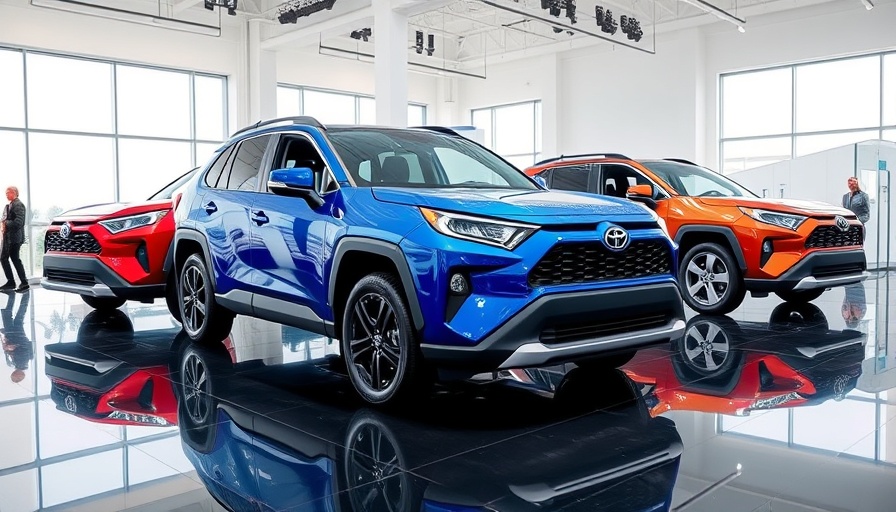
The 2026 Toyota RAV4: A Bold New Direction for Crossover SUVs
Toyota is making a significant statement with the introduction of the 2026 RAV4, a vehicle that aims to redefine the expectations of crossover SUVs. As the best-selling crossover in America, the RAV4 has always attracted a diverse range of drivers, and this latest overhaul signals an ambitious move into the hybrid market. Embracing sustainability while enhancing performance, Toyota’s shift to an entirely hybrid lineup is more than just a response to eco-trends; it’s a strategic pivot.
Hybrid Power for Everyone: What to Expect
The standout feature of the new RAV4 is its exclusive hybrid powertrain, marking a departure from traditional gas-only engines. With the base model delivering a formidable 226 horsepower and the all-wheel-drive variant offering 236 horsepower, consumers can look forward to both improved fuel efficiency and enhanced driving dynamics. While exact MPG ratings remain under wraps, the anticipated benefits of this shift are significant, especially for those who prioritize eco-friendly driving.
Moreover, Toyota isn’t leaving plug-in enthusiasts behind with the new RAV4 Plug-In Hybrid. This model replaces the previous RAV4 Prime, unleashing an impressive 320 horsepower. Additionally, the upgraded all-electric driving range has increased from 42 to 50 miles, addressing a crucial need among drivers for efficiency in urban settings. Toyota has integrated advanced technology in the plug-in model, including faster charging options that offer versatility across different trim levels.
Trims and Features: A Closer Look
The RAV4’s new trim structure categorizes the lineup into Core Design, Rugged Design, and Sport Design, each catering to different consumer needs. Core Design includes popular trims like the LE and Limited, all motivated by the standard hybrid system. The rugged Woodland trim is a nod to adventure-seekers, outfitted with all-terrain tires and essentials for off-road capabilities. On the performance side, the sportier SE and the newly introduced GR Sport represent Toyota’s aggressive push to bring excitement back to driving.
While the GR Sport isn’t a true Gazoo Racing model, it holds its ground by providing superior performance features such as larger wheels, a distinct front grille, and an interior boasting suede touches that appeal aesthetically and enhance comfort. This commitment to both style and performance positions the RAV4 as a versatile contender in a competitive market.
Technology and Safety Advancements
Technology within the 2026 RAV4 leaps ahead with standard installations of a 10.5-inch infotainment screen and a 12.3-inch digital gauge display. Upgrading to a massive 12.9-inch touchscreen is available on higher trims, ensuring that drivers have access to cutting-edge features such as wireless Apple CarPlay and Android Auto. Toyota also emphasizes safety with its new Safety Sense 4.0 package, which expands on features like adaptive cruise control and introduces new elements designed to enhance driver and passenger safety.
Market Trends: The Future of Crossover SUVs
The 2026 RAV4 arrives at a pivotal moment in the automotive industry, where consumer preference increasingly leans towards hybrid and electric vehicles. As the market for environmentally conscious cars expands, major manufacturers are racing to adapt. Toyota’s proactive approach positions it well against competitors as the industry shifts dramatically. With comprehensive sustainability strategies and innovative design, the 2026 RAV4 represents a crucial response to changing market dynamics.
Conclusion: A Compelling Option for New Car Buyers
The 2026 Toyota RAV4’s unique features reflect the automotive industry's shift towards hybrid technology while keeping performance and customer needs in focus. As this latest model hits showrooms, potential buyers can expect a well-rounded vehicle that fulfills the demands of modern driving without compromising on power or efficiency.
For those considering a new car, the 2026 RAV4 should be on their radar. It embodies the evolution of the crossover segment and offers robust choices for a variety of lifestyles. With hybrid technology becoming a standard expectation, Toyota's latest RAV4 stands poised to lead the charge.
 Add Row
Add Row  Add
Add 




Write A Comment